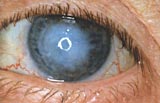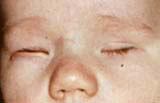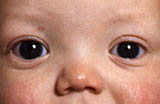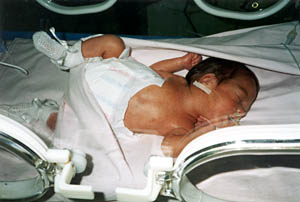10. CAUSES OF VISUAL IMPAIRMENT/DISABILITY
Some vision impairments are diagnosed at birth because of changes in the outer eye or because of signs of a syndrome where vision impairment is known to regularly occur. In this group belong children with microphtalmia, cloudy cornea, often with simultaneous changes in iris and lens, coloboma of iris and congenital cataract and glaucoma.



When an infant, whose eyes look normal, does not develop normal eye contact at the end of the second month or the eyes have irregular roving movements instead of usual fixating of objects and quick saccades, suspicion of something being wrong brings the infant to an ophthalmologist or to the child's paediatrician.
 Prematurely born infants' common problem is disturbance of development of vessels in the retina. This may lead to formation of abnormal vessels that easily bleed and during scar formation may detach parts of or the whole retina from the underlying choroid. Present early follow-up of retinal development in prematurely born infants and the use freezing and laser coagulation of the new formed vessels, retina surgery when necessary, have decreased the number of blind infants but a number of infants have some decrease in visual functions.
Prematurely born infants' common problem is disturbance of development of vessels in the retina. This may lead to formation of abnormal vessels that easily bleed and during scar formation may detach parts of or the whole retina from the underlying choroid. Present early follow-up of retinal development in prematurely born infants and the use freezing and laser coagulation of the new formed vessels, retina surgery when necessary, have decreased the number of blind infants but a number of infants have some decrease in visual functions.
Congenital glaucoma may start to cause symptoms at the age of a few months but usually does not cause vision impairment in infancy. Many infants and toddlers are functionally disturbed by the frequent application of glaucoma medications and photophobia. Their general development may be disturbed by the operations and measurement of intraocular pressure even several times of day.
At the age of a few months to a few years retinoblastoma, tumour of the retina, may appear in one or both eyes. Often the tumour is in both eyes and one eye needs to be removed, the other eye may be treated with radiation, laser coagulation and medications. In some cases both eyes need to be removed to save the child's life.
Brain damage is an increasingly common cause of severe vision impairment in infants. It may be caused by asphyxia, poor circulation before, at or after birth, by infections, by trauma, both accidental and non-accidental traumas, or be a part of generalised functional disturbance of the brain as in Down Syndrome and in different malformations of the brain. These infants often have seizures, need to get strong medications and thus are poorly awake. They may have damage to the primary visual pathways or to the cortical or subcortical visual functions or both. Because of the poor general condition of these infants vision impairment is often diagnosed quite late, rarely before the age of six months, except when the infant does not have any visual communication or does not seem to look at anything. Quite often the child's neurologist has accepted poor visual development as a sign of intellectual disability, not knowing that the quality of the visual image was poor and thus difficult to interpret.